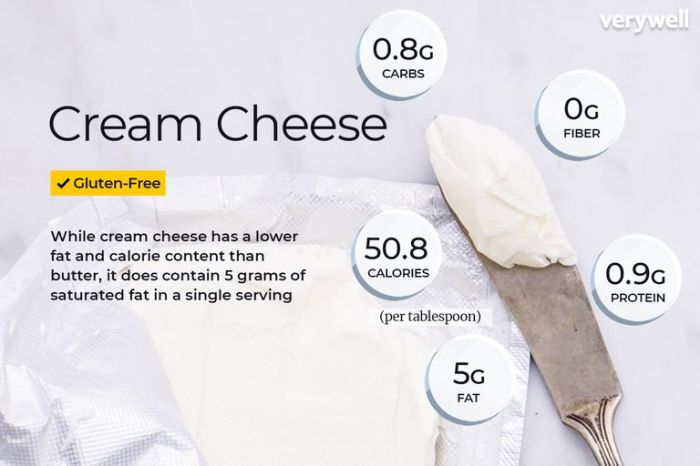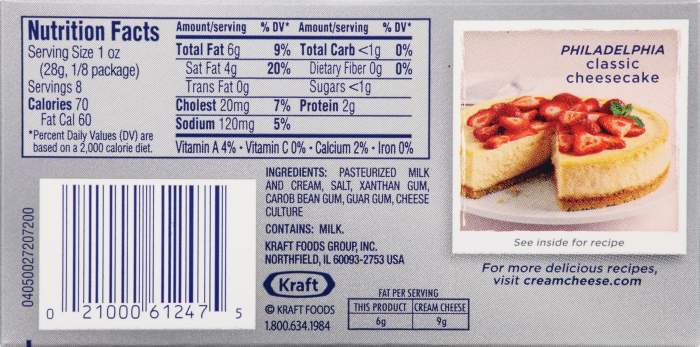Cream Cheese Varieties and Nutritional Differences: Cream Cheese Nutrition Facts

Cream cheese nutrition facts – Cream cheese, a beloved dairy product, comes in various forms, each with its own unique nutritional profile. Understanding these differences is crucial for making informed choices that align with individual dietary needs and preferences. Factors such as fat content and added ingredients significantly impact the overall nutritional value.
Different types of cream cheese offer varying levels of fat, calories, and protein. These variations stem primarily from the manufacturing process and the inclusion of additional components. Consumers should be aware of these differences to make choices that best suit their dietary goals.
Nutritional Comparison of Cream Cheese Varieties
The following table summarizes the nutritional information for three common cream cheese varieties: regular, low-fat, and whipped. Note that these values are approximate and can vary slightly depending on the brand and specific product.
| Cream Cheese Type | Serving Size (oz) | Calories | Fat (g) |
|---|---|---|---|
| Regular | 1 | 100-110 | 10-11 |
| Low-Fat | 1 | 60-70 | 3-4 |
| Whipped | 1 | 50-60 | 2-3 |
As the table illustrates, regular cream cheese is significantly higher in calories and fat compared to low-fat and whipped varieties. Low-fat options reduce the fat content by using less cream or adding skim milk solids, resulting in fewer calories. Whipped cream cheese incorporates air, which reduces the overall density and, consequently, the calories and fat per serving. However, it’s important to note that the protein content remains relatively consistent across these varieties.
Impact of Added Ingredients on Nutritional Profile, Cream cheese nutrition facts
The addition of herbs, spices, fruits, or other flavorings can alter the nutritional content of cream cheese. These additions may introduce extra sugars, carbohydrates, or even beneficial vitamins and minerals, depending on the specific ingredients.
Understanding cream cheese nutrition facts is crucial for mindful eating. For a broader perspective on the nutritional content of popular sandwich fillings, you might also want to check out the detailed breakdown available at jersey mike’s nutrition facts , which offers a good comparison point when considering high-fat ingredients like cream cheese. Returning to cream cheese, remember to consider portion sizes to manage your overall daily intake of saturated fat and calories.
- Fruit-flavored cream cheeses: Often contain added sugars, increasing the carbohydrate and calorie content. The nutritional value is enhanced if the fruit is naturally sweet and contains additional vitamins and fiber. For example, a blueberry cream cheese might contain added sugar, but also antioxidants from the blueberries.
- Herb and spice infused cream cheeses: Generally have a minimal impact on the overall nutritional profile, primarily adding flavor without significantly altering the calorie or fat content. However, some spice blends may contain added sodium.
- Vegetable cream cheeses: Depending on the vegetables added, these may provide additional vitamins, minerals, and fiber. However, this can also slightly increase the carbohydrate content.
Cream Cheese in a Balanced Diet

Cream cheese, with its rich and creamy texture, is a popular ingredient in many dishes. However, its high fat content necessitates careful consideration within a balanced diet. Understanding its nutritional profile and incorporating it mindfully can allow enjoyment without compromising overall health goals.Cream cheese’s high fat content, primarily saturated fat, is its main nutritional drawback. Excessive saturated fat intake is linked to increased cholesterol levels and an elevated risk of heart disease.
Therefore, moderation is key. Conversely, cream cheese provides a source of protein and calcium, contributing to satiety and bone health. It also contains small amounts of vitamins and minerals, though not in significant quantities. The benefits of cream cheese consumption are largely dependent on the quantity consumed and the overall dietary context.
Cream Cheese Consumption and Health Implications
Regular, excessive consumption of cream cheese can contribute to weight gain due to its high caloric density. This is particularly true when paired with other high-calorie foods. Conversely, moderate consumption as part of a balanced diet, rich in fruits, vegetables, and whole grains, can be incorporated without significant negative health consequences. Individual tolerance and metabolic responses will vary, but focusing on portion control is crucial.
For example, a serving size of one ounce of cream cheese contains approximately 100 calories and 8 grams of fat. Exceeding this amount consistently will likely lead to unwanted weight gain and increased saturated fat intake.
Sample Meal Plan Incorporating Cream Cheese
A balanced meal plan can easily include cream cheese in moderation. Consider these examples:
Breakfast: A whole-wheat bagel (approximately 150 calories) topped with 1 ounce of cream cheese (approximately 100 calories) and a thin layer of sliced tomato and cucumber. This provides a balanced combination of carbohydrates, protein, and healthy fats, along with vitamins and minerals from the vegetables. The total calorie count for this breakfast is approximately 250 calories.
Lunch: A large salad (approximately 200 calories) with mixed greens, grilled chicken breast (approximately 150 calories), and a tablespoon (approximately 50 calories) of cream cheese-based dressing. This provides a balanced combination of lean protein, healthy fats, and fiber. The total calorie count for this lunch is approximately 400 calories.
Snack: A small apple (approximately 100 calories) with 0.5 ounces of cream cheese (approximately 50 calories). This provides a combination of fiber, natural sugars, and healthy fats. The total calorie count for this snack is approximately 150 calories.
These examples demonstrate how cream cheese can be incorporated into a healthy diet through mindful portion control and careful pairing with nutrient-rich foods. Remember that these are sample portions and calorie counts may vary depending on specific brands and preparation methods. Consult a registered dietitian or nutritionist for personalized dietary advice.
FAQ Insights
Is cream cheese a good source of protein?
While cream cheese does contain protein, it’s not a primary protein source compared to lean meats or legumes. The protein content varies depending on the type of cream cheese.
Does cream cheese contain lactose?
Yes, regular cream cheese contains lactose. Lactose-free options are available for individuals with lactose intolerance.
Can I use cream cheese in baking?
Absolutely! Cream cheese is a popular ingredient in many baked goods, adding richness and moisture. However, the high fat content should be considered when calculating overall fat content in recipes.
What are some healthy ways to eat cream cheese?
Use it sparingly as a spread on whole-wheat crackers or vegetables, incorporate it into savory dips or sauces in moderation, or use it in small amounts in recipes like muffins or quick breads.




